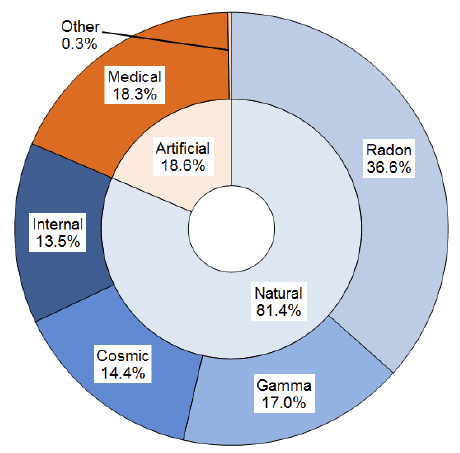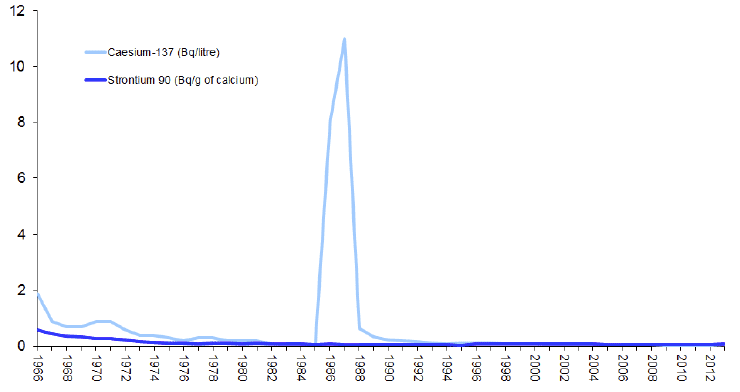Key Scottish Environment Statistics 2014
This publication aims to provide an easily accessible reference document which offers information on a wide range of environmental topics. It covers key datasets on the state of the environment in Scotland, with an emphasis on the trends over time wherever possible. The data are supplemented by text providing brief background information on environmental impacts, relevant legislation and performance against national and international targets.
This document is part of a collection
Radioactivity
Exposure of the Population to All Sources of Radiation: 2010[1]
Average annual dose in Scotland, 2,300 microsieverts[2]

In 2010, the average annual dose of radiation to someone living in Scotland was 2,300 microsieverts, this has fallen from 2,400 microsieverts in 2003. At 81%, the majority of the annual dose comes from natural sources.
The greatest source of natural radiation exposure is radon, a radioactive gas that is emitted from tiny amounts of uranium naturally present in materials such as rocks, soils, bricks and concrete. Radon decays and emits short-lived products that can increase the risk of lung cancer. The action level for radon in the home is 200 Bq/m3, above which measures should be taken to reduce concentrations. Other important natural sources of radiation are terrestrial gamma rays, cosmic rays, and long-lived radionuclides that enter the body through food and drink (classed as internal in the above chart).
The greatest artificial source of exposure to radiation comes from medical x-rays. Nuclear waste disposals and fall-out account for less than 0.3% of exposure. The Chernobyl reactor incident in 1986 caused average annual doses from fall-out to increase by about five times that year.
Source: Health Protection Agency - Radiation Protection Division / Metadata
Activity Concentrations in Milk: 1966-2013[3]

Exposure to ionising radiation from radioactive substances can have an impact on human health. For this reason a number of foodstuffs are monitored each year to assess that the public has been adequately protected from ionising radiation.
Cows' milk is measured because air-borne radioactive particles falling on pasture are taken up by grazing animals and passed onto their milk. This concentrates radioactive materials from the grazing range of the animals, effectively giving a very large surveillance area. Samples of milk are bulked from a number of farms to give the final activity concentration for Scotland.
From 1966 until 1980, there were gradual falls in the concentrations of Caesium-137 (137Cs) and Strontium-90 (90Sr) until the concentration was so low it was difficult to detect. This reflects a decline in atmospheric radioactive fall-out, following the ban on above-ground nuclear weapons testing under the 1963 Partial Test Ban Treaty between the UK, USA and former USSR.
Following the Chernobyl reactor incident in 1986, concentrations of137Cs in milk peaked in 1987 and then began to fall again and are now below pre-Chernobyl levels.[4] In 2013, the concentration of 137Cs was <0.052 Bq/litre and 90Sr was <0.083 Bq/gram of calcium. However, even at its peak, the 137Cs concentration in milk following the Chernobyl accident was around 100 times lower than the Community Food Intervention Levels, defined by Euratom Regulations EC/3954/87 and EC/2218/89, which were derived to ensure the protection of the public.
Contact
Email: Kirsty Ciclitira
There is a problem
Thanks for your feedback